|
|
Welcome to my travel log! You will find here a lot more than in the travel reports, stripped from political correctness. Enjoy! 
Sep 09, 2004 02:00 PM Peru - Huanchaco
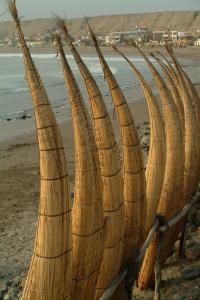 Huanchaco is small cute fishing village with good beach and brilliant surfing conditions. The beach is not the cleanest in the world, but hey – it is sandy.
Huanchaco is small cute fishing village with good beach and brilliant surfing conditions. The beach is not the cleanest in the world, but hey – it is sandy.
The surfing conditions are said to be among the best on the planet. The waves are long and high. There are many people arriving there (and a bit farther in the north) to try their skills. Even small kids surf!
Caballitos, the totora reed boats, are in large numbers stood up along the coast, and I thought it would be difficult to find them. Firstly, I thought they are just for decoration, but when I saw a man coming from the ocean on one of them, I knew I was wrong. I remained amazed however, how those little, single-man boats manage to overcome the power of those mighty waves?!
Huanchaco is also brilliant for seafood. There are a number of restaurants at the ocean front, and almost all of them had local crowd in them, indicating that food must have been good there. I went to Estrella Marina and fell in love with giant shrimp in garlic sauce.
|
Sep 08, 2004 02:00 PM Peru - Chan Chan, Chimu civilisation remains
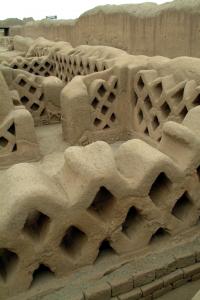 Chan Chan is again on the UNESCO list and let me, again, quote what they say about it:
Chan Chan is again on the UNESCO list and let me, again, quote what they say about it:
“The Chimu Kingdom, with Chan Chan as its capital, reached its apogee in the 15th century, not long before falling to the Incas. The planning of this huge city, the largest in pre-Columbian America, reflects a strict political and social strategy, marked by the city's division into nine 'citadels' or 'palaces' forming autonomous units.”
The site is in danger, and it was included in the list of UNESCO sites in danger in 1986, the same year it was inscribed. As the city is built entirely of mud, it is prone for quick erosion from air and water. Fortunately, by the time of the El Niño in 1997 and 1998, emergency plans have been implemented with the assistance from the World Heritage Fund, and the impact of weather was moderate.
The site of Chan Chan, with the very impressive Palace Tschudi, walled around with many surviving decorations, impressed me the most – picture above. The site is unexpectedly magnificent and vast. It is so large that a modern road runs through this ancient mud city.
The site feels like Egypt but the structures are not made of granite or any other stone but made of mud. However, I could not resist this comparison, particularly as the Chimu people were building pyramids just like the Egyptians.
I began wondering how coincidental this must be because the civilisations were so remotely located one from another. Is there a way that they could have known about one another, is the hypothesis of Mr. von Dänicken a better explanation?
The pyramids of Chimu are called huacas. The first I saw was the Huaca La Esmeralda. It is rather unimpressive and located in a dangerous area.
And, this is the area where you do not want to realise you have a puncture, but this is exactly what happened to my taxi driver! Fortunately, he was able to change the wheel as I was wandering around this small (and poorly restored) huaca.
Huaca del Dragon was the second on my list. It is also a small pyramid and also situated in the middle of the town but this one has a better location and is nicely decorated. It is sometimes called Huaca del Arco Iris, because the main decoration of the structure is a couple of dragons under a rainbow. Rainbow in the Chimu culture had an important representation in one of the powerful deities.
In the compound of the pyramid, there was a man making and selling replicas of the ancient ceramic pottery. His work was rather good. It was allegedly so good, that he had to put a word ‘replica’ on them to ensure his customers have no trouble on the airports exporting the goods.
He was a very skilled and polite person, and as I liked the items – mainly pots – I decided to acquire some. They were also very reasonably priced. I bought three pots and two emblems. At that point of my holiday, I did not care about dragging them around the country in my backpack, because I was leaving for home in two days.
Huaca del Sol was next and it was the greatest disappointment ever. It is left to its own and to the desert. It is almost completely ruined and requires imagination to see that once it was a pyramid - one of the largest in its time on this planet. Have a quick glance at it on the far left picture on the bottom of the previous page.
Huaca de la Luna – much smaller than its sister (del Sol) but it is beautifully decorated and it seems that time for all the centuries did little damage.
Fortunately, the Chimu sites are conveniently located near Trujillo and Hunachaco, that to visit them all one requires only 4-5 hours.
The best way to do the trip is to hire a taxi for half a day. This is very easy as the taxis are absolutely everywhere, and I am under the impression that there is actually more taxis than passengers. The taxis are like mountain lions or pumas – they spot you well before you spot them. Contrary to the wild cats, however, they kindly inform you about the fact that they had spotted you by blowing their horn. During the day, that could easily be a hundred or two hundred times. It may start pissing you off.
|
Sep 07, 2004 02:00 PM Peru - Trujillo
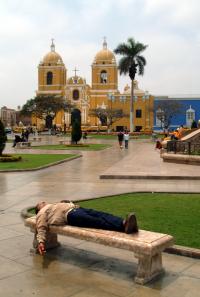 A very pleasant colonial centre with brightly coloured facades Trujillo has. Low buildings dominate in the city, which is due to ever-present danger of earthquakes.
A very pleasant colonial centre with brightly coloured facades Trujillo has. Low buildings dominate in the city, which is due to ever-present danger of earthquakes.
It is a third largest city in Peru, and similarly to Arequipa there is a large number of cafes and places to relax. However, the Plaza Mayor (I think this could be the one that for a change is not officially named Plaza de Armas) is not as attractive as the one in Arequipa.
Also, the people in Trujillo are very well dressed and there is no-one wearing traditional clothing. This would be consistent with the general observation that the coastal towns are more laid back than those in the highlands.
Unfortunately, the coastal towns are prone for higher level of crime. I will always remember Trujillo as a town of cheaters in the street around Plaza Mayor who nag you to exchange currency with them. They offer better exchange rates but hand you forged money in exchange.
This is what happened to a fellow traveller of mine, an investment banker, who was incredibly picky about the exchange rates. If the rate was 3.32 PEN to a US dollar, he would not change there because he would expect an exchange rate of 3.35! So, he decides to go with the street crook, and loses fifty bucks! How clever is that?
Well, I think the situation would have been better if we did not think that, by then, we knew the local money so well, that it seemed unlikely that someone could pull a trick like that. Well, the forged money was very well done. The only thing that gave it away was that the paint on the number 50 (the actual amount on the banknote) did not change colour when examined at a different angle.
False coins, which are absolutely everywhere, are easier to spot, and I mastered that perfectly. This is so unfair for the foreigners who have absolutely no clue that this is what they are faced with.
Trujillo was not a key destination for me. What I wanted to see in the area was the monuments remaining from the Chimu civilisation. I did not actually stay in Trujillo at all.
Instead, I chose a fishing village Huanchaco, famous for its reed boats called caballitos, which are similar to those used on the Lake Titicaca, however with a difference that those on the coast, have one flat end.
|
Sep 06, 2004 02:00 PM Peru - Cordillera Blanca, Churup
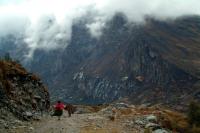 The next day, weather further declined, which prevent me from succeeding to force myself climbing to Lago Churup.
The next day, weather further declined, which prevent me from succeeding to force myself climbing to Lago Churup.
Already at 4,000m I decided to visit a few small villages at the feet of Churup, instead. It was a very good decision as it actually rained and snowed for a while. And I hate snow and being wet!
The same evening, as soon as I finished my Thai dinner listening to Annie Lennox (special request of mine) for the third consecutive night, I boarded a night bus to Trujillo.
|
Sep 05, 2004 02:00 PM Peru - Cordillera Blanca, Lago 69
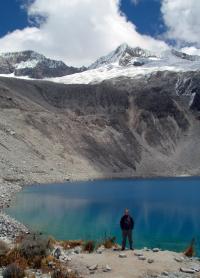 The next day was the trek to Lago 69 at the feet of mountains Pisco 5,752m and the second most difficult mountain in the world – Chacraraju 6,112m.
The next day was the trek to Lago 69 at the feet of mountains Pisco 5,752m and the second most difficult mountain in the world – Chacraraju 6,112m.
It was an early start for a day trek, and I was already pissed off that weather betrayed me again. It was very cloudy and it looked like there were no mountains around at all. Nothing could be seen. So much for me seeing the Huascaran, I thought.
Fortunately, the sky cleared a bit later that morning and I could barely see the legendary peaks. What I could see, you can now see on the previous page. This is how good it got that moment when I took the picture, but then the peaks got completely covered again.
The trail to Lago 69 could also be called shitty trail. Not because it was not nice, but because there was so much shit on the trail. The shit was left by cows and donkeys. There was so much shit everywhere like there were at least ten thousand cows and donkeys there.
So, can you imagine how shocked I was to find out later that there were only twelve cows and eight donkeys! I was impressed with their appetite.
The trek itself was not too hard but the altitude of 3,000-4,600 meters leaves you out of breath and you have to navigate between the shit everywhere.
The lake is small and not too special but the views to Pisco and Chacraraju, and their glaciers took even more breath away.
I was sad that I could not see in full the peaks of Huandoy 6,395m and Huascaran, but the Yanapaqcha at 5,460m was eventually uncovered with nice glaciers as well.
I was glad not to meet too many people on the way. The scenery, although in mediocre weather was for my eyes only at that moment.
|
Sep 04, 2004 02:00 PM Peru - Huaraz
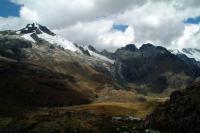 Huaraz is a small town of no longer inspiring architecture due to the May 1970 earthquake, but it is situated miraculously among Cordillera Blanca, which becomes part of the town.
Huaraz is a small town of no longer inspiring architecture due to the May 1970 earthquake, but it is situated miraculously among Cordillera Blanca, which becomes part of the town.
I arrived at 5am when it was still dark and quickly checked in to Hostal Montañero, and went to bed for four hours.
I took it easy that morning. Not only had I travelled a thousand miles for the last two days and two nights, but also descended and ascended almost 5,000 metres within 48 hours. Patapampa above Chivay (3,600m) was at the elevation of 4,920m, Lima at sea-level and Huaraz again at 3,091m. I was impressed with my body that it took it very well, without even slightest headache.
I had a plan in mind. I wanted to do a couple of one-day treks in the mountains and there were two things I wanted to see. The first one was the highest peak of Peru – the Huascaran, standing 6,768m or 22,205ft. The second – a panoramic view of the mountain range, and potentially a lake and a glacier high in the mountains.
I looked up a few trekking agencies in town and went enquiring what would be the best for me to pick from the long list of treks to accommodate my very clear requirements. This could have not been easier. If you have cash, then you can do anything there in the Andes.
I booked two trips with a private taxi, and then could relax in this small town, with absolutely nothing to do. And they are closing for siesta!
I sat down at the top of dead fountain in the very centre of the Plaza de Armas, which was poorly restored after the earthquake. I spoke to kids and other people. One of them, a dentist migrated from Lima, told me the legend of Huascaran.
Here it is:
Prince Huascaran was truly and deeply in love with Princess Huandoy from neighbouring kingdom. Unfortunately, the kingdoms were at war. Their love was like a forbidden fruit. It was totally off limits. One day the Prince was spotted by his father’s guards, the lovers were brought to their parents who tied the lovers' hands behind their backs. Standing at the front of each other they cried their eyes out which in centuries turned into ice - two peaks - Huascaran and Huandoy.
Then, the time has come to eat something. I was so pleased with myself that I found a Thai restaurant that I felt I should have got a medal for it. The name of the restaurant was Siam de Andes and it serves absolutely yummy Thai buffet. Two starters and one main course cost 28 PEN or 8 USD. That could not be any better! The Pad Thai is arguably the best Pad Thai dish in the entire Western Hemisphere. This wonderful restaurant saved me from eating another guinea pig or fried and questionably fresh trout.
Plus they were playing the fantastic Annie Lennox’s album – Bare, which complemented the entire experience. I had heaven in my mouth (green curry) and heaven in my ears, what else to ask for?
My other activity that day was buying CDs from street sellers. Something was telling me these were not genuine copies but there were not other music shops in the Cordillera Blanca of the Andes. When I returned home and opened the boxes, I realised that I was right. They were brutally computer-burned copies. Well, though.
|
Sep 03, 2004 02:00 PM Peru - Nazca Lines
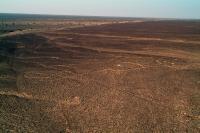 The next Peru’s attraction of the itinerary was the Nazca Lines. They were quite distant from Arequipa and the only way of getting there is by road. This means taking a bus.
The next Peru’s attraction of the itinerary was the Nazca Lines. They were quite distant from Arequipa and the only way of getting there is by road. This means taking a bus.
There are a number of bus companies in Peru and quality differs considerably. The two most reputable and reliable are Ormeño and Cruz Del Sur, and possibly also Flores.
The best way to travel by bus in Peru is by night. There are number of reason for me saying that. First, the night services are more comfortable with very well reclining seats to the position of semi-bed. Second, one saves money on the accommodation for the night and at the same time makes progress in the travel. Third, one usually gets to sleep with windows covered with curtains and therefore does not get terrified with the sight of the ‘adventurous’ driving on the poor roads. I had a quick look for one moment and I was amazed one can drive big ten wheels bus so fast and take tight turns without even touching the breaks. I preferred not to watch that, to be honest.
Nazca has been a big disappointment to me. And possible the only regret for which I can only blame myself that I did not end up doing what I originally wanted and long planned to do – take a plane to see the lines from the air.
I was stupid to listen to some of the travellers met on this holiday and thought it would be okay to see the lines from the ground. A huge mistake!
It is not possible to see the figures from the ‘famous’ viewpoints. The picture above presents one of the smaller figures – the Hands. One can also see the Tree, but all the other, more interesting figures are out of sight.
Airplane is essential. People should not listen to the wimps who claim that the flights are too bumpy with too many tight turns that make you sick. I cannot be that bad as there are hundreds of travellers who take those planes and nothing ever happens to them. Instead, they are ecstatic to be able to see most of the famous Nazca figures.
|
Sep 02, 2004 02:00 PM Peru - the Colca Canyon, the Cruz del Condor
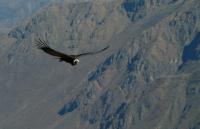 Next morning was the culminating point of the tour. The majority of the clouds disappeared and the morning sunrays gave great light and contrast. And the condors were there!
Next morning was the culminating point of the tour. The majority of the clouds disappeared and the morning sunrays gave great light and contrast. And the condors were there!
The point is called Cruz del Condor and is the only point on this planet where these large birds can be seen almost everyday. Condors are second largest flying and birds on this planet as of today (the largest is Albatross) with wingspan up to 4 meters. What makes the spot so special is that these Andean Vultures are on the verge of extinction, so to be able to see them in wild in their natural habitat is absolutely electrifying.
Apparently, the birds have nests across the canyon, at the other rim. They get up early in the morning to fly with the thermals – currents of warm air. The best time to spot condors is around 7 am, where they fly low, and it feels like if one reaches out, it would be possible to touch them. I could not verify it, but they are said also to return to the Cruz in the evening.
Various numbers of condors can be seen these days. I was lucky to see ten or eleven birds, including adult male and female as well as a number of young ones. The adult birds have white collar around the neck and the young ones are all dark brown.
Another endemic animal of South America that I managed to see that day was the vicuña. It belongs to the cameloid family together with the llama, alpaca and the very rare nowadays guanaco. There is an entire colony (not sure if this is the right word though) of vicunyas near the road from Arequipa to the Colca Canyon.
Vicunyas are smaller than llamas and alpacas and are generally not being domesticated. Their fur is extremely expensive and I was told that a jumper made of vicuña’s wool would cost me around a thousand of US dollars.
On the way back to Arequipa I noticed how significant the difference in the air pressure on the elevations between the 4,920m and 2,340m is. That was very clear to see as the plastic water bottles dramatically change shapes. They look like something sucked out all the air from inside of them.
|
Sep 01, 2004 02:00 PM Peru - the Colca Canyon
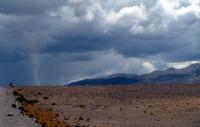 Colca Canyon was not in the plans originally, since there was little time and I spotted it late in the planning stage. However, as I kept reading about it I ever hesitated whether I should have included it anyway cutting some time off other places. Well, I eventually left it as a flexibility option, which may be reconsidered as I speak to the fellow travellers whilst already in Peru. That was a wise thing to do.
Colca Canyon was not in the plans originally, since there was little time and I spotted it late in the planning stage. However, as I kept reading about it I ever hesitated whether I should have included it anyway cutting some time off other places. Well, I eventually left it as a flexibility option, which may be reconsidered as I speak to the fellow travellers whilst already in Peru. That was a wise thing to do.
For a number of years, Colca Canyon had been considered the deepest canyon in the world until an even deeper canyon was discovered nearby – the Cotahuasi Canyon. Well, I wanted to see that and as the book said the surrounding area was spectacular, which is in fact, very true.
I finally decided to include Colca Canyon in this trip after speaking to people met on the road previously during the trip. They went and recommended it. It could not have been easier to put on the plan – the number of days from four were cut to two for the Cordlillera Blanca, and from two to one for Arequipa, and the trip was bought from one of the travel agencies in close to the Santa Catalina monastery.
As with many things in Peru, the trip to the canyon could be done in a few ways. One of them was a two days trip with some hiking in the mountains and night in a hotel in the town called Chivay. The other was a two or three days trek in the canyon with camping at the bottom of it. I personally chose sleeping in a hotel option.
The way up from Arequipa revealed a very dry landscape with average views. Basically, it was a vast gravel desert. The area was such an isolated place that it felt like it was the end of the world. It was actually amazing to see that there was a railway and a road in the middle of nowhere. There were no settlements for miles and miles, and the road did feel like it was leading absolutely nowhere.
Only after a while, better views become available like the Volcano El Misti, which did not appear to be that distant at all, although it a few hours to get to the point with the view.
In addition, some incredible weather-related phenomena started to appear. One of them were unbelievable rain clouds. I still do not believe that I actually saw things like this. Gladly I took a photograph of it and now I can share it.
The other one was a tornado-like twister. That was a first time I actually witnessed a full-scale twister. It was not large, maybe F1 or even less than that, but it was real and I was flabbergasted to see one.
For these events alone, this trip was worthwhile, and I was not even half way to the canyon.
As the car continued to climb, a few snow capped peaks started appearing on the horizon, which eventually disappeared behind bad weather’s clouds.
The highest point of 4,920m (16,142ft) at Patapampa en route was supposed to uncover an astonishing view to six volcanoes in the area. I waited for that as the following volcanoes were supposed to be easily visible: the Mismi (5,556m/18,228ft), Sabancaya (5,976m/19,606ft), the Ampato (6,288m/20,630ft), the Hualca Hualca (6,025m/19,767ft) and even very distant the Coropuna (6,425m/21,079ft).
That was actually utterly disappointing because weather prevented viewing any of the volcanoes. It was miserable, it was snowing and I did not even get out of the car.
Not to worry, I thought. I was on this escapade to see the canyon and the giant condors. All of that was still before me then, so I had my fingers crossed.
|
Aug 31, 2004 02:00 PM Peru - Arequipa
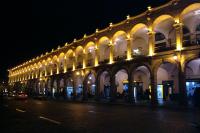 I was gobsmacked by the beauty of Arequipa and the area already at the airport as soon as I landed. The numerous volcanoes standing around this town complement its beauty and charm. It was a few times destroyed by the volcanoes and earthquakes. The volcanoes are the ultimate destructive power as they trigger deadly earthquakes and ruin the city. However, this is the volcanoes, at the other had, which provided the main building material – volcanic sillar rock. It is a very nice white rock, which contributed to Arequipa’s nick name of ‘white city’.
I was gobsmacked by the beauty of Arequipa and the area already at the airport as soon as I landed. The numerous volcanoes standing around this town complement its beauty and charm. It was a few times destroyed by the volcanoes and earthquakes. The volcanoes are the ultimate destructive power as they trigger deadly earthquakes and ruin the city. However, this is the volcanoes, at the other had, which provided the main building material – volcanic sillar rock. It is a very nice white rock, which contributed to Arequipa’s nick name of ‘white city’.
Plaza de Armas in Arequipa is one of the most picturesque squares on the entire continent. Three sides of the square are made of full-length two storey buildings with arcades. The forth side is the cathedral, which not only does take the full length of the plaza but also has a façade on the full length of the church! That is something. And guess what? In the central point of the plaza there is a little garden with benches, palm trees, flowers and a fountain. Surprise, surprise.
There is even more to Arequipa than the above. I think already mentioned the volcanoes with snow caps, like the one closest to the city called Misti (in Quechua language misti means mister – el señor) standing 5,822 meters. But did I mention the climate and weather? Well, Arequipa enjoys an eternal spring. The temperature remains at 23-25C (73-77F) during the day and at night it stays at 14C (57F). That is very comfortable at the elevation of 2,325 meters (7,628 feet) and this is for the entire year with average sunny days of 360 days a year. Now, this is not bad at all, ha?
After Cusco, Arequipa has the best preserved colonial architecture in Peru and the fact that the buildings are made of white volcanic stones makes the city absolutely stunning. I could wander around for hours and soak the ambiance and the history of this place.
In addition, there is a monastery of Santa Catalina (picture above). The convent is like a walled around little town within a city. It painted in traditional red, brown and blue. The interesting fact about the monastery is that it did not necessarily represent the nuns’ vows of poverty.
The sisters enjoyed rather luxurious accommodation with some upper scale furnishing. I also heard that they partied rather heavily, which came to the Pope’s attention one day and who ordered them to leave the convent for a while and see what nun’s life should really taste like.
The vast majority of the monastery is now available for the public to visit and the nuns have reserved a small bit for themselves. What can be visited today is a large area and it takes couple of hours to see absolutely everything. The colours of the buildings are so vivid that it makes this place a heaven for photographers.
From one of the roofs of the houses within the monastery there is a magnificent view to the volcanoes.
Similar view is almost directly available from the Plaza de Armas in the centre, however not from the street level. I tried and tried to take a perfect picture of the plaza and the volcanoes in the background but it was simply impossible without having to climb either on the roof of the arcaded building or at least onto one of the balconies.
I actually thought I could pull this off because the perfect spot for the picture was situated in the office of the city’s tourist information.
However, when I wandered there early in the morning for the best light condition, the office was still closed and I achieved absolutely nothing.
Arequipa is a city of many bars, restaurants and clubs like Krakow in Poland or Dublin in Ireland. In the evening, the face of this city changes and this white innocent place turns into a magnificent party and going out centre. I liked that very much I felt I could stay in the town for a week or two.
I actually stayed quite centrally at Hostal Katty (calle Alvarez Thomas) with had pleasant clean rooms with hot shower and the possibility to store luggage while gone for a day or two to the Colca Canyon. That was one of the best places I stayed at in Peru and very convenient, too. Travellers met on the boat to the Taquile island on Lake Titicaca recommended this hostal.
I forgot to mention that Arequipeños are very proud people and, since Arequipa is an important cultural centre and the second largest city of Peru, they resent the common opinion that everything is run out of Lima.
They even introduced their own flag and put it up everywhere it is acceptable to have it. I really liked and I would have been proud myself had I been born in Arequipa. It is truly a marvellous place.
|
Page:
 92 93 94 95 96 97 98 99 100 101 102
92 93 94 95 96 97 98 99 100 101 102

|
|
|
